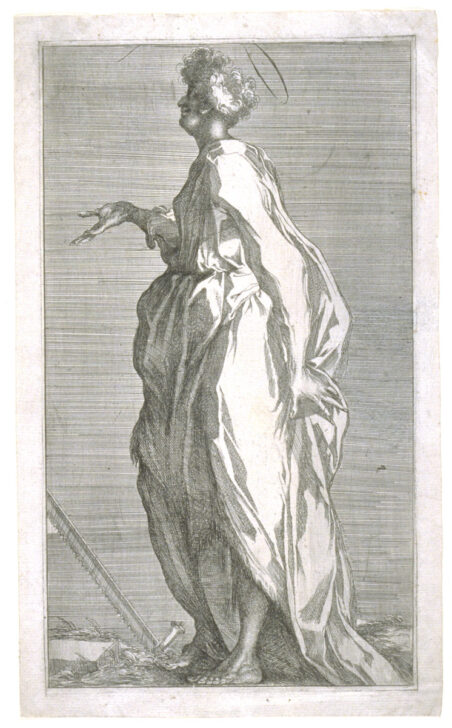St. Simon
Jacques Bellange

Description
Gallery Rotation Spring/Summer 2011
Jacques Bellange
France, circa 1575–1616
Saint Simon
circa 1616
Etching
Gift of the Friends of the Museum of Art in memory of Mrs. John Alexander, 1992/2.1
Though Jacques Bellange was one of the most influential French painters of the sixteenth century, nearly all of his paintings have been lost and his reputation now stands on the evidence of his remaining prints and drawings. Not much is known of the artist’s life outside of his work for the court in what is now the Lorraine area of France, but it is believed that he took up etching only about five years before his death and supervised the printing of his copperplates himself. The surviving etchings are principally religious figures, including images from the life of Christ, as well as sets of the three Magi and the twelve Apostles.
This etching of St. Simon is part of a set of Apostles showing the saints as single monumental figures. The saint fills the plate and stands against a background of horizontal hatched lines. There is no real attempt at naturalism: the light flickering over the drapery leaves his face largely in shadow and the emphasis on the hands, along with the attenuated proportions of the figure, contributes to the expressive power of the etching. Bellange’s eccentric—and eclectic—style reflects the influence of both Italian and Dutch mannerist artists, who had a penchant for elegant figures with sinuous and elongated forms.
Subject Matter:
This print portrays an apostle of Jesus Christ, St. Simon the Zealot. In art, he is usually depicted with a saw which is a reference to his martyrdom.
Though Jacques Bellange was one of the most influential French painters of the sixteenth century, nearly all of his paintings have been lost and his reputation now stands on the evidence of his remaining prints and drawings. Not much is known of the artist’s life outside of his work for the court in what is now the Lorraine area of France, but it is believed that he took up etching only about five years before his death and supervised the printing of his copperplates himself. The surviving etchings are principally religious figures, including images from the life of Christ, as well as sets of the three Magi and the twelve Apostles.
Physical Description:
This black and white print has a vertical format with a single standing figure. The figure, shown in profile, has the right arm upraised with palm up. He is wearing voluminous drapery and has a halo and bare feet. There is a long bladed saw on the ground beside him.
Usage Rights:
If you are interested in using an image for a publication, please visit https://umma.umich.edu/request-image/ for more information and to fill out the online Image Rights and Reproductions Request Form.